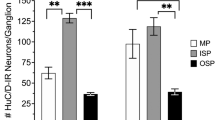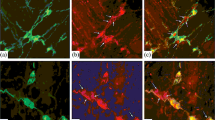Abstract
Acetylcholine is not only a neurotransmitter but is also produced by several non-neuronal cell types with barrier or defence function. One of the non-neuronal tissues with expression of the key enzyme for production of acetylcholine, the choline acetyltransferase (ChAT), is the colonic surface epithelium, which releases acetylcholine after contact with the short-chain fatty acid propionate produced physiologically in the colonic lumen during the microbial fermentation of carbohydrates. Despite the fact that the caecum is the largest fermentation chamber in non-ruminant mammals, nothing is known about the expression and function of a non-neuronal cholinergic system in this part of the large intestine, which was addressed in the present study. In Ussing chamber experiments, propionate induced a concentration-dependent Cl− secretion leading to an increase in short-circuit current (Isc), which was stronger in the aboral part (near the blind ending sac of the caecum) compared to the oral part of caecum. The propionate-induced Isc was blocked by atropine, but was resistant against tetrodotoxin, conotoxins (MVIIC and SVIB) or hexamethonium indicating that propionate acts via non-neuronal acetylcholine. Immunohistochemical staining revealed the expression of ChAT in the caecal surface epithelium with a significant gradient between aboral (high) and oral (low) expression. This difference combined with a higher efficiency of cholinergically induced anion secretion (as revealed by the Isc evoked by the cholinergic agonist carbachol) is probably responsible for the segment dependency of the response to propionate. In summary, propionate stimulates anion secretion in rat caecum via non-neuronal acetylcholine emphasizing the physiological importance of the non-neuronal cholinergic system in the communication between the gastrointestinal microbiome and the mammalian host.







Similar content being viewed by others
References
Antuszewicz A, Taciak M, Zebrowska T (2005) The short-chain fatty acid content in the caecal digesta of rats fed diets with various sources of fibre. J Anim Feed Sci 14(Suppl. 1):521–524. https://doi.org/10.22358/jafs/70722/2005
Argenzio RA, Southworth M (1974) Sites of organic acid production and absorption in gastrointestinal tract of the pig. Am J Phys 228:454–460
Bader S, Diener M (2015) Novel aspects of cholinergic regulation of colonic ion transport. Pharmacol Res Perspect 3(3):e00139. https://doi.org/10.1002/prp2.139
Bader S, Klein J, Diener M (2014) Choline acetyltransferase and organic cation transporters are responsible for synthesis and propionate-induced release of acetylcholine in colon epithelium. Eur J Pharmacol 733:23–33. https://doi.org/10.1016/j.ejphar.2014.03.036
Bader S, Lottig L, Diener M (2017) Stimulation of Na+-K+-pump currents by epithelial nicotinic receptors in rat colon. Brit. J. Pharmacol. 174(9):880–892. https://doi.org/10.1111/bph.13761
Bugaut M (1987) Occurrence, absorption and metabolism of short chain fatty acids in the digestive tract of mammals. Comp Biochem Physiol 86B:439–472
Catterall WA (1980) Neurotoxins that act on voltage-sensitive sodium channels in excitable membranes. Annu Rev Pharmacol Toxicol 20(1):15–43. https://doi.org/10.1146/annurev.pa.20.040180.000311
Church DC (1988) The Ruminant animal: digestive physiology and nutrition, 2.ed. edn. Prentice Hall, London
Escobar E, Ibarra C, Todisco E, Parisi M (1990) Water and ion handling in the rat cecum. Am J Phys 259:G786–G791
Franklin JL, Willard AL (1993) Voltage-dependent sodium and calcium currents of rat myenteric neurons in cell culture. J Neurophysiol 69(4):1264–1275. https://doi.org/10.1152/jn.1993.69.4.1264
Haberberger R, Schultheiss G, Diener M (2006) Epithelial muscarinic M1 receptors contribute to carbachol-induced ion secretion in mouse colon. Eur J Pharmacol 530(3):229–233. https://doi.org/10.1016/j.ejphar.2005.11.055
Hammer R, Giachetti A (1980) Muscarinic receptor subtypes M1 and M2. Biochemical and functional classification. Life Sci 31:2991–2998
Haschke G, Schäfer H, Diener M (2002) Effect of butyrate on membrane potential, ionic currents and intracellular Ca2+ concentration in cultured rat myenteric neurons. Neurogastroenterol Mot 14(2):133–142. https://doi.org/10.1046/j.1365-2982.2002.00312.x
Hennig B, Schultheiss G, Kunzelmann K, Diener M (2008) Ca2+-induced Cl− efflux at rat distal colonic epithelium. J. Membrane Biol 221:61–72
Karasov WH, Douglas AE (2013) Comparative digestive physiology. Comprehen. Physiol 3:741–783
Klapproth H, Reinheimer T, Metzen J, Münch M, Bittinger F, Kirkpatrick CJ, Hohle KD, Schemann M, Racké K, Wessler I (1997) Non-neuronal acetylcholine, a signalling molecule synthezised by surface cells of rat and man. Naunyn Schmiedeberg's Arch Pharmacol 355(4):515–523. https://doi.org/10.1007/PL00004977
Lesko S, Wessler I, Gäbel G, Petto C, Pfannkuche H (2013) Cholinergic modulation of epithelial integrity in the proximal colon of pigs. Cells Tiss Org 197(5):411–420. https://doi.org/10.1159/000345437
Lindqvist SM, Sharp P, Johnson IT, Satoh Y, Williams MR (1998) Acetylcholine-induced calcium signaling along the rat colonic crypt axis. Gastroenterology 115(5):1131–1143. https://doi.org/10.1016/S0016-5085(98)70084-8
Mestres P, Diener M, Rummel W (1990) Storage of glycogen in rat colonic epithelium during induction of secretion and absorption in vitro. Cell Tissue Res 261(1):195–203. https://doi.org/10.1007/BF00329452
Mitsuya M, Mase T, Tsuchiya Y, Kawakami K, Hattori H, Kobayashi K, Ogino Y, Fujikawa T, Satoh A, Kimura T, Noguchi K, Ohtake N, Tomimoto K (1999) J-104129, a novel muscarinic M3 receptor antagonist with high selectivity for M3 over M2 receptors. Bioorg Med Chem 7(11):2555–2567. https://doi.org/10.1016/S0968-0896(99)00177-7
Moreno S, Gerbig S, Schulz S, Spengler B, Diener M, Bader S (2016) Epithelial propionyl- and butyrylcholine as novel regulators of colonic ion transport. Brit. J. Pharmacol. 173(18):2766–2779. https://doi.org/10.1111/bph.13555
Nassenstein C, Wiegand S, Lips KS, Li G, Klein J, Kummer W (2015) Cholinergic activation of the murine trachealis muscle via non-vesicular acetylcholine release involving low-affinity choline transporters. Int Immunopharmacol 29(1):173–180. https://doi.org/10.1016/j.intimp.2015.08.007
Natarajan N, Pluznick JL (2014) From microbe to man: the role of microbial short chain fatty acid metabolites in host cell biology. Am J Physiol Cell Physiol 307(11):C979–C985. https://doi.org/10.1152/ajpcell.00228.2014
Oltmer S, von Engelhardt W (1994) Absorption of short-chain fatty acids from the in-situ-perfused caecum and colon of the guinea pig. Scand J Gastroenterol 29(11):1009–1016. https://doi.org/10.3109/00365529409094878
Padilla F, Couble ML, Coste B, Maingret F, Clerc N, Crest M, Ritter AM, Magloire H, Delmas P (2007) Expression and localization of the Nav1.9 sodium channel in enteric neurons and in trigeminal sensory endings: implication for intestinal reflex function and orofacial pain. Mol Cell Neurosci 35(1):138–152. https://doi.org/10.1016/j.mcn.2007.02.008
Poulsen JH, Fischer H, Illek B, Machen TE (1994) Bicarbonate conductance and pH regulatory capability of cystic fibrosis transmembrane conductance regulator. Proc Natl Acad Sci U S A 91(12):5340–5344. https://doi.org/10.1073/pnas.91.12.5340
Sachs L (1992) Angewandte Statistik. Springer, Berlin, p 360. https://doi.org/10.1007/978-3-662-05747-6
Schemann M, Sann H, Schaaf C, Mäder M (1993) Identification of cholinergic neurons in enteric nervous system by antibodies against choline acetyltransferase. Am J Phys 265:G1005–G1009
Schreiner J, Weber M, Loeschke K (1998) Sodium chloride transport of normal and dietary enlarged rat cecum in vitro. Digestion 59(6):676–682
Seamon KB, Padgett W, Daly JW (1981) Forskolin: unique diterpene activator of adenylate cyclase in membranes and in intact cells. Proc Natl Acad Sci U S A 78(6):3363–3367. https://doi.org/10.1073/pnas.78.6.3363
Schultheiss G, Diener M (1997) Regulation of apical and basolateral K+ conductances in the rat colon. Brit J Pharmacol 122(1):87–94. https://doi.org/10.1038/sj.bjp.0701353
Sellin JH, Hall A, Cragoe EJ Jr, Dubinsky WP (1993) Characterization of an apical sodium conductance in rabbit cecum. Am J Phys 264:G13–G21
Sellin JH, Dubinsky WP (1994) Apical nonspecific cation conductance in rabbit cecum. Am J Phys 266:G475–G484
Snipes RL (1981) Anatomy of the cecum of the laboratory mouse and rat. Anat Embryol 162(4):455–474. https://doi.org/10.1007/BF00301871
Strabel D, Diener M (1995) Evidence against direct activation of chloride secretion by carbachol in the rat distal colon. Eur J Pharmacol 274(1-3):181–191. https://doi.org/10.1016/0014-2999(94)00728-P
Vyskočil F, Malomouzh AI, Nikolsky EE (2009) Non-quantal acetylcholine release at the neuromuscular junction. Physiol Res 58(6):763–784
Wessler I, Kilbinger H, Bittinger F, Unger R, Kirkpatrick CJ (2003) The non-neuronal cholinergic system in humans: expression, function and pathophysiology. Life Sci 72(18-19):2055–2061. https://doi.org/10.1016/S0024-3205(03)00083-3
Yajima T, Inoue R, Matsumoto M, Yajima M (2011a) Non-neuronal release of ACh plays a key role in secretory response to luminal propionate in rat colon. J Physiol 589(4):953–962. https://doi.org/10.1113/jphysiol.2010.199976
Yajima T, Inoue R, Yajima M, Tsuruta T, Karaki S, Hira T, Kuwahara A (2011b) The G-protein on cholesterol-rich membrane microdomains mediates mucosal sensing of short-chain fatty acid and secretory response in rat colon. Acta Physiol 203(3):381–389. https://doi.org/10.1111/j.1748-1716.2011.02331.x
Yajima M, Kimura S, Karaki S, Nio-Kobayashi J, Tsuruta T, Kuwahara A, Yajima T, Iwanaga T (2016) Non-neuronal, but atropine-sensitive ileal contractile responses to short-chain fatty acids: age-dependent desensitization and restoration under inflammatory conditions in mice. Physiol Rep 4(7):e12759. https://doi.org/10.14814/phy2.12759
Acknowledgements
The diligent technical assistance of Mrs. Brigitta Brück, Bärbel Schmidt and Alice Stockinger is a pleasure to acknowledge.
Author information
Authors and Affiliations
Corresponding author
Ethics declarations
Experiments were approved by the named animal welfare officers of the Justus Liebig University (administrative number 577_M) and performed according to the German and European animal welfare law.
Rights and permissions
About this article
Cite this article
Bader, S., Diener, M. Segmental differences in the non-neuronal cholinergic system in rat caecum. Pflugers Arch - Eur J Physiol 470, 669–679 (2018). https://doi.org/10.1007/s00424-017-2104-x
Received:
Revised:
Accepted:
Published:
Issue Date:
DOI: https://doi.org/10.1007/s00424-017-2104-x




